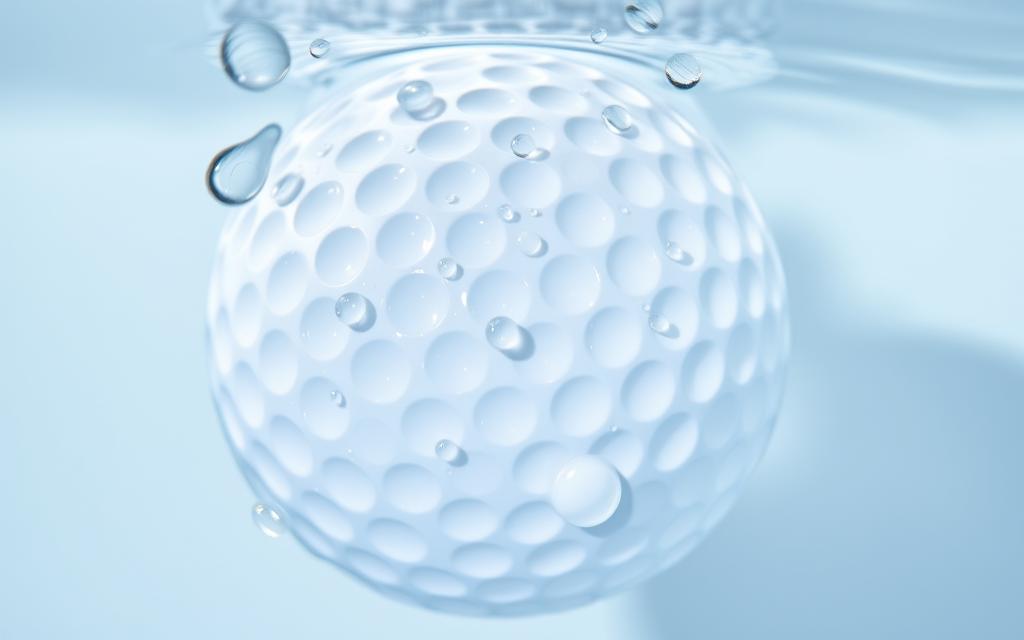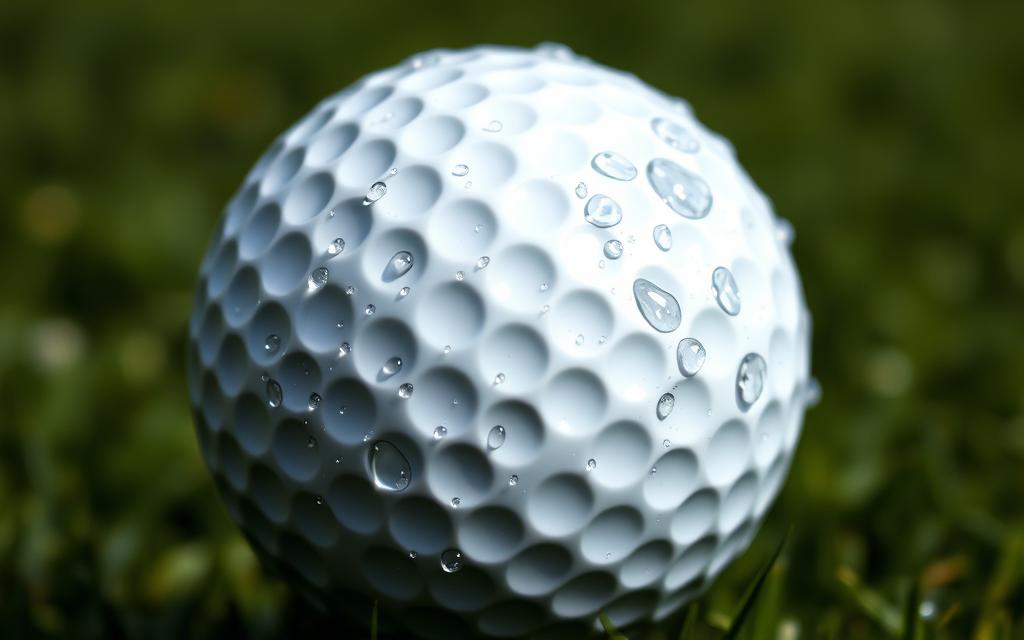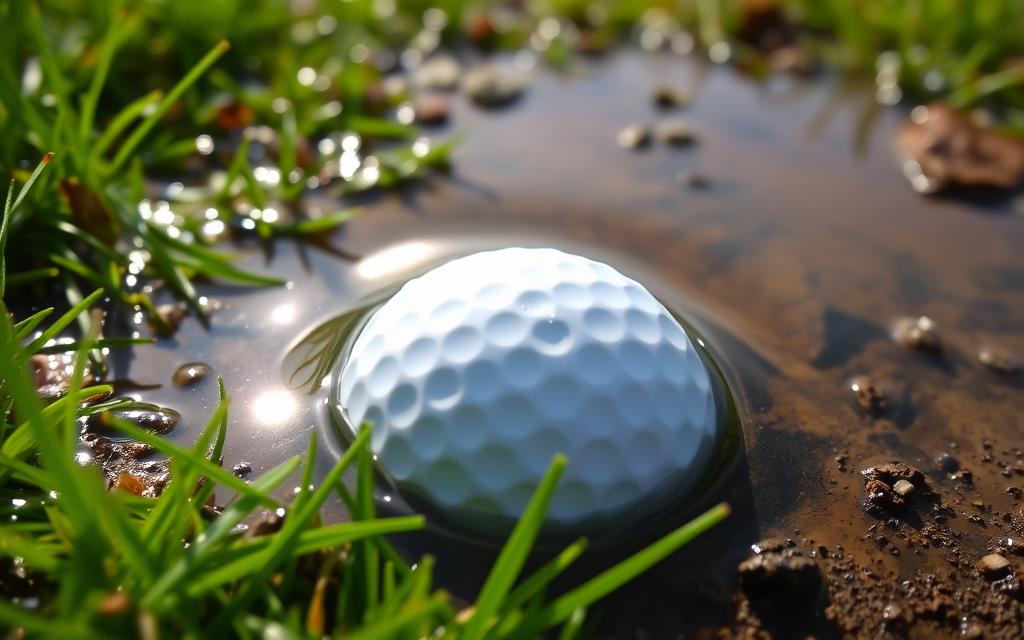Ever found a golf ball that felt heavy or spongy? It might be waterlogged. But can golf balls really get waterlogged? And how does it affect your game? Let’s explore the science behind water absorption in golf balls and its impact on your game.
Key Takeaways
- Golf balls can become waterlogged if exposed to too much moisture or bad storage.
- Waterlogging changes how a ball feels and performs, affecting distance and control.
- It’s important to check balls for waterlogging to keep them playing well.
- Storing balls right and playing in the rain helps prevent waterlogging.
- Replacing waterlogged balls is often needed to keep your game good.
Understanding Golf Ball Composition
To know how golf balls fight water, we must look at their make. Modern golf balls are made to perform well, and staying dry is key to this.
Materials Used in Golf Balls
Golf balls have many layers, each with its own job. The core is often a strong, water-resistant material like a special polymer. It’s wrapped in mantles and a tough, waterproof cover, usually ionomer resin or urethane.
| Layer | Purpose | Common Materials |
|---|---|---|
| Core | Provides distance and power | Polymers, rubber blends |
| Mantle(s) | Enhances control and spin | Ionomers, thermosets |
| Cover | Delivers durability and feel | Ionomer resin, urethane |
How Construction Affects Water Resistance
The golf ball construction is key to fighting water. A strong, water-resistant core and a waterproof cover keep the ball dry. This lets it play well, even when it’s wet.
Learning about golf ball materials and design shows us their strength. They’re made to play well, no matter the weather.
The Science of Waterlogging
The science of how golf balls absorb water is really interesting. The ball’s inside and the materials used affect how it handles moisture. Exploring [https://mattguides.com/can-golf-balls-get-waterlogged/] will show you how moisture changes a golf ball’s performance.
What Happens When a Golf Ball Absorbs Water
When a golf ball meets water, it starts to soak it up. This can change the ball’s weight, density, and core. The more water it absorbs, the heavier it gets, affecting its flight and distance.
Water also changes the ball’s compression and bounce. This can make the ball feel different during play.
Indicators of a Waterlogged Golf Ball
- Visible signs of water absorption, such as a dull or discolored appearance
- Increased weight or heft when held in the hand
- Reduced distance and accuracy off the tee
- Altered feel and feedback during the swing and impact
- Decreased spin rates and reduced control around the greens
These signs help you know if a golf ball is waterlogged. They let you take steps to keep your gear in top shape. Knowing about water absorption helps you protect your golf balls. This way, they’ll always perform well, no matter the weather.

Common Situations Leading to Waterlogging
It’s key to stop golf ball water damage to play well. Golf balls can handle some wet, but wrong play or storage can cause waterlogging. Knowing these common issues helps you keep your golf balls in top shape.
Playing Conditions That Contribute
Wet play is a big reason for golf ball waterlogging. Rain, standing water, or dew can soak your balls. This makes them lose their water resistance and messes up their golf ball dimple patterns.
- Frequent play in rainy or damp weather
- Hitting shots from water hazards or saturated ground
- Leaving golf balls in the dewy grass overnight
Storage Mistakes to Avoid
Storing golf balls wrong can also cause golf ball waterlogging. Not drying them right can make them absorb water. This can lead to mold or mildew, hurting their play.
- Storing golf balls in damp or humid environments
- Failing to thoroughly dry golf balls after play in wet conditions
- Leaving golf balls in the trunk or back of your vehicle for extended periods
Being aware of these issues and taking steps to prevent golf ball water damage keeps your balls ready for play.
Impacts of Waterlogging on Performance
Waterlogging a golf ball can really mess with your game. It changes how far the ball goes, how well you can control it, and how it feels. Knowing these changes helps golfers play better.
Effects on Distance and Control
Water makes a golf ball heavier, so it goes shorter distances. It also messes with the ball’s path, making shots harder to control. The moisture affects golf balls, leading to unpredictable shots.
Changes in Feel and Feedback
Waterlogging changes how a golf ball feels and responds. A wet ball feels heavier and less alive, making it hard to judge your swing. This can hurt your game.
Golf ball makers have created golf ball hydrophobic coatings. These coatings keep water away, helping the ball stay in top shape. They’re great for playing in the rain or when the weather changes fast.
“Proper storage and maintenance of your golf balls can go a long way in preventing waterlogging and preserving their performance on the course.”
Knowing how waterlogging affects golf balls and using hydrophobic coatings helps. You can play better in wet conditions and keep your ball performing well.

Preventing Waterlogging in Golf Balls
Keeping your golf balls dry is key to their performance and life. Simple steps for storage and playing in wet can stop waterlogging. This can ruin your game.
Best Practices for Storage
Proper storage keeps your golf balls dry and ready. Store them in a cool, dry spot, away from sunlight and moisture. Use a waterproof container or case for extra protection.
Don’t leave your golf balls in your car, not even in warm or humid weather. Temperature and humidity changes can make balls absorb water. Keep them with you only when you play, and store them safely at home or in your bag.
Tips for Playing in Wet Conditions
- Invest in waterproof golf ball materials to resist water. Look for durable, hydrophobic coatings.
- Wipe your golf balls dry with a clean towel before each shot. This is important in rainy or humid weather.
- Use a golf ball cover or sleeve to protect them from water while playing.
- Avoid playing in standing water or puddles. This can quickly cause preventing golf ball water damage.
By following these tips, you can prevent golf ball water damage. This helps keep your golf balls performing well for longer.
Detecting Waterlogged Golf Balls
It’s important to know if a golf ball is waterlogged. This affects how well it plays and how long it lasts. We’ll look at how to spot water damage and test your golf balls.
Visual and Physical Signs to Look For
A waterlogged golf ball looks dull and discolored. Its shiny surface might look hazy or mottled. It also feels heavier and softer than a dry ball.
- Dull, discolored appearance
- Hazy or mottled finish
- Heavier weight
- Softer, squishy texture
Testing Methods You Can Use
For more proof, try a water displacement test. Put the ball in a container of water. A wet ball sinks, while a dry one floats. You can also weigh the ball before and after to see how much water it holds.
| Test | Dry Ball | Waterlogged Ball |
|---|---|---|
| Water Displacement | Floats | Sinks |
| Weight Comparison | Lighter | Heavier |
By checking how it looks and testing it, you can tell if a golf ball is waterlogged. This helps you decide if it’s good to use or needs to be replaced.
When to Replace Waterlogged Golf Balls
As a golfer, knowing when to replace your golf balls is key. This is true when they’ve been soaked in water. Some balls can handle a little dampness, but too much water can hurt their performance and last.
Understanding Longevity and Usability
Golf balls soaked in water lose their shape and how they fly. Water gets into the ball’s core, changing its weight and feel. This makes the ball fly unevenly and not as far.
Also, a wet ball feels soft and heavy. It doesn’t give you the right feel and control when you hit it.
Best Options for Replacement Golf Balls
When your golf balls are too wet, it’s best to get new ones. Look for Titleist and Callaway golf balls. They have special designs that help them stay dry and last longer.
These balls are made to handle wet conditions better. Using the right drying methods can keep your game strong, even when it’s raining.


